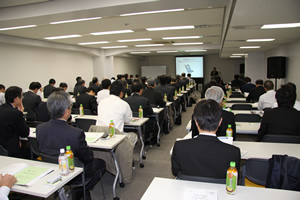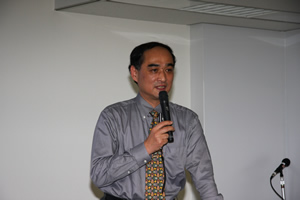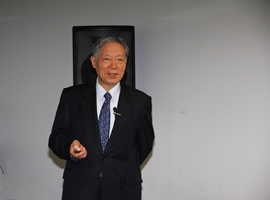|
|
 |

During the Presentation
|
The 18th Managers’ Seminar was held at the TKP Tamachi Business Center Minato-ku, Tokyo on December 4, 2008with 66 management-class personnel from member organizationin attendance. Following the opening remarks by President Fujie, the seminar proceeded with lectures that focused on the common challenges and initiatives related to safety culture which have been brought up in the course of the various activities (Safety Caravan sessions, safety cultural climate surveys, onsite assessments, etc.) carried out by the Nuclear Safety Network Division, and a common awareness of these challenges and initiatives was fostered amongst members. |

Mr.Kenichi Takano, Professor,
Graduate School of System Design
and Management, Keio University
|
Lectures
First Session
Lecture Title: “Safety Culture: Its Perception and Practice
– Strategies for Accident Prevention through Shared Individual, Team and Organizational Values –”
Professor Kenichi Takano, Graduate School of System Design and Management, Keio University
Companies are faced with a variety of risks. And the truth is that it is impossible to put in place a perfect system to guard against them all. Given this situation, what are needed to effectively counter risks are safety-oriented values shared by all members of an organization: from executives to managers to rank-and-file employees. This challenge concerns issues of ethics, compliance, and safety culture, and it cannot be successfully addressed without addressing core, ‘mindset’ issues.
Safety culture depends upon the four foundations of organizational culture (motivation, governance, commitment, and communication) and the four foundations of business management (risk awareness, work management learning, and resource management).
With regard to motivation, it is important to create a structure which generates it. The results of surveys reveal that motivation levels are still insufficient. Motivation affects all aspects of safety activity; thus, raising motivation as much as possible represents a significant future challenge.
With regard to governance, it is important that a “Safety is Key” mindset permeate the entire organization. To accomplish this, executives need to be onsite and personally dealing with individual issues. Furthermore, they must be concerned with the overall value of the company and not just the shareholder value.
With regard to commitment, it is important that a strong sense of ownership be cultivated. In order to do this, it is crucial that a variety of creative safety activities be implemented and that people not be allowed to fall into a rut.
With regard to communication, it is particularly important to have measures for communicating with junior members. Also, another challenge is to create an atmosphere or put in place an information system which encourages reporting, even of difficult or unpleasant subjects.
With regard to risk awareness, it is important everyone remain dedicated in their work and pick up on and thoroughly respond to small risks.
With regard to communicated learning, it is crucial that training and instruction not be done ad hoc but be implemented in a systematic fashion. And when introduced, it needs to contain a combination of “onsite training” and “safety-related training”.
With regard to work management, a high quality of work must be promoted, i.e., quality control is required.
Finally, with regard to resource management, for those work sites with an imbalance in personnel composition, it is crucial that they find a way to close the generation gap.
Today’s nuclear power industry calls for the solid establishment of an underpinning “organizational climate and culture” which is rooted in these eight areas. |
Second Session
Lecture Title: “Safety Culture’s Key People – Middle Managers –”
President Shojiro Matsuura, Nuclear Safety Research Association

|
Mr.Shojiro Matsuura,President,
Nuclear Safety Research Association
|
My interpretation of the term ‘Safety culture’ would be “an ingrained philosophy, attitude and habit of putting safety first”.
The value of safety can be assessed from the standpoint of the “right to demand safety” and is one of the basic human rights ensured by the constitution. This is because it is only when safety is ensured that people can begin to act freely and be profitable. Safety culture is regarded as the most important basis for ensuring safety.
There are four key factors required for creating and maintaining safety culture: 1) Questioning Attitudes, 2) Careful and Reliable Thinking and Behavior, 3) Well-developed Communication, and 4) Vigilance against Complacency.
The flip side of these four factors are several factors which will destroy safety culture. Major examples include overconfidence in good experiences or excellent performance, indifference or blindness to displeasing elements, over-reliance on past successes or precedent, promotion of organizational vested interests, and constriction or breakdown of communication. By checking the state of the organization in relation to these factors, it is possible to assess the health of its safety culture; however, the key principle when doing this is to use an original mechanism created and utilized by you yourself.
During opinion exchanges held onsite, topics such as the enervation caused by the severe climate surrounding nuclear energy, the level of awareness employees should have, the difficulty of passing on experience and technology, and the difficulty of communication inside and outside of facilities are raised as issues to be addressed. Also, the “gap in safety awareness” between nuclear technicians and local residents / the general public is an issue which cannot be ignored and which requires sustained communication in order to minimize.
It is the middle managers who play the most important role in creating and maintaining organizational safety culture. They have built up sufficient experience over their long careers to know full well what safety culture demands. Furthermore, it is the middle managers who play an important linking role in organizational communication, such as between upper management and the onsite workforce and between the onsite workforce and affiliate companies.
Japanese culture is firmly rooted in the idea that “those at the top make all the decisions and those at the bottom just do what they’re told”. In order to overcome the shortcomings of this kind of thinking, it is the middle managers who know the actual situation onsite, and not the upper management, who need to be central in supporting the creation and implementation of safety activities. |
In the questionnaire after the seminar, the following opinions were expressed.
(1) In regard to the presentation by Professor Kenichi Takano, Graduate School of System Design and Management, Keio University
・The content of this session is extremely useful for systematically organizing safety culture. The handouts were detailed and can be put to use at a later date.
・The thinking, items for implementation and procedural understanding of safety culture were well developed; however, I would have liked to receive many more improvement examples.
・The subject of this lecture was “safety”; however, it could just as easily have been “quality”. I am in charge of quality assurance, and in addition to working on finding ways to improve behavior, such as better compliance with procedural manuals, I work on finding ways of improving attitude surveys focused on employee quality. I hope to directly apply the content of this session into the quality assurance activities at my organization. It was extremely informative. I found the example of the New York subway particularly informative, with its demonstration of the idea that you should properly eliminate small risks if you want to eliminate big risks.
(2) In regard to the presentation by President Shojiro Matsuura of the Nuclear Safety Research Association
・The lecture was easy to understand, including the explanation given of the relationship between Japanese culture and ‘Safety culture’. Also, I feel it captured the role and importance of middle managers. It was a heartening message to hear as a middle manager.
・I felt that the key factors mentioned for fostering safety culture included important factors that go beyond safety. I will endeavor to make extensive use of these factors.
・It was extremely beneficial to hear a former Chair of the Nuclear Safety Commission discuss their philosophy regarding safety culture. The lecture by the professor who is a specialist in safety culture was also good, but I hope there can be more opportunities like this to hear from those at the top of the nuclear energy industry.
・I feel ‘nuclear power safety culture’ will become an important point of contact with society. I hope next time we will hear about how to raise awareness of its connection to nuclear power and engage society.
・This session really drove home the point that safety culture is not just some knowledge to have in your head but something which should directly inform your behavior. Even in cases where in-house rules exist, it is important that employees’ motivation for carrying out fundamental operations, etc., not be “because that’s what’s written in the regulations”.
|
|
|







